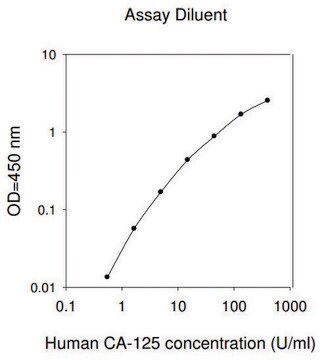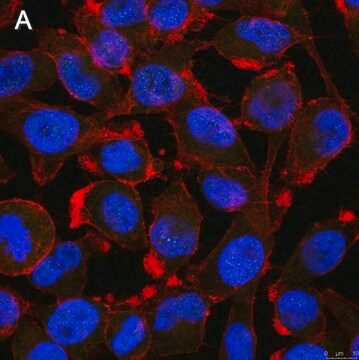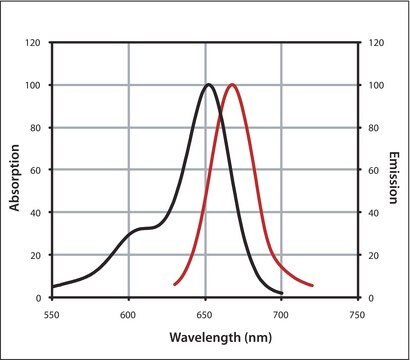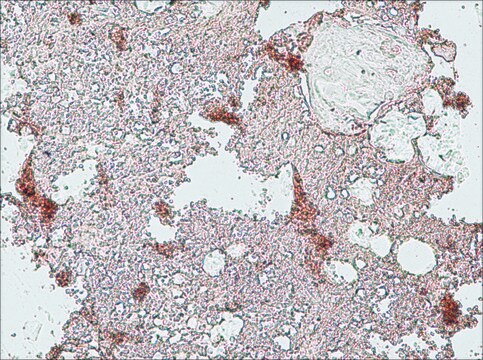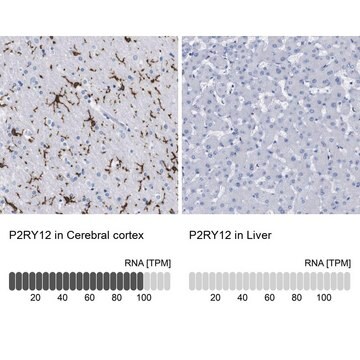Opis ogólny
Jesteśmy zaangażowani w dostarczanie bardziej ekologicznych produktów alternatywnych, które są zgodne z co najmniej jedną z 12 zasad zielonej chemii. To przeciwciało nie zawiera konserwantów, jest produkowane bez szkody dla zwierząt i wyjątkowo stabilne, aby umożliwić wysyłkę i przechowywanie w razie potrzeby, a tym samym jest zgodne z "Zapobieganiem powstawaniu odpadów", "Projektowaniem bezpieczniejszych chemikaliów" i "Projektowaniem pod kątem efektywności energetycznej".
Kliknij tutaj, aby uzyskać więcej informacji.
Przeciwciała 10889 stanowią całkowicie nową generację rekombinowanych przeciwciał monoklonalnych. Każde przeciwciało 10889 jest wytwarzane przy użyciu naszego zastrzeżonego systemu ekspresji rekombinowanej, oczyszczane do jednorodności i precyzyjnie dozowane w celu uzyskania solidnej i wysoce powtarzalnej konsystencji między partiami. Do użytku badaczy udostępniane są wyłącznie klony o najwyższej wydajności. Każde przeciwciało jest walidowane pod kątem wysokiej swoistości i powinowactwa w wielu zastosowaniach, w tym w najczęściej używanym zastosowaniu. Przeciwciała 10889 są niezawodnie dostępne i gotowe do wysyłki, gdy są potrzebne.
Specyficzność
Klon 1B6 to rekombinowane królicze przeciwciało monoklonalne 10889, które specyficznie wykrywa anhydrazę węglanową 9 (CA9). Celuje w epitop w obrębie 24 aminokwasów od domeny cytoplazmatycznej w regionie C-końcowym.
Immunogen
Liniowy peptyd sprzężony z KLH odpowiadający 24 aminokwasom z C-końcowej domeny cytoplazmatycznej ludzkiej anhydrazy węglanowej 9 (CA()).
Zastosowanie
Testy kontroli jakości
Oceniane metodą Western Blotting w lizacie tkanki okrężnicy szczura.
Analiza Western Blotting: Rozcieńczenie 1:1000 tego przeciwciała wykryło CA9 w lizacie tkanki okrężnicy szczura.
Testowane aplikacje
Analiza Western Blotting: Rozcieńczenie 1:1000 z reprezentatywnej partii wykryło CA9 w lizacie tkanki ludzkiego żołądka.
Test wiązania powinowactwa: Reprezentatywna partia tego przeciwciała wiązała CA9 z KD wynoszącym 9,2 x 10-8 w teście wiązania powinowactwa.
Analiza immunohistochemiczna (parafina): Rozcieńczenie 1:1000 z reprezentatywnej partii wykryło CA9 w wycinkach tkanki ludzkiego żołądka.
Analiza immunocytochemiczna: Rozcieńczenie 1:100 z reprezentatywnej partii wykryło CA9 w komórkach A431.
Uwaga: Rzeczywiste optymalne rozcieńczenia robocze muszą być określone przez użytkownika końcowego jako próbki, a warunki eksperymentalne mogą się różnić w zależności od użytkownika końcowego.
Opis wartości docelowych
Anhydraza węglanowa 9 (UniProt: Q16790; znana również jako EC:4.2.1.1, dehydrataza węglanowa IX, anhydraza węglanowa IX, CA-IX, CAIX, antygen błonowy MN, P54/58N, antygen związany z rakiem nerkowokomórkowym G250, antygen związany z RCC G250, pMW1) jest kodowana przez gen CA9 (znany również jako G250, MN) (Gene ID: 768) u człowieka. Opisano sześć różnych ewolucyjnie klas anhydraz węglanowych (CA) (α, β, γ, δ, ζ i η). Jednak tylko klasa α ulega ekspresji u ssaków. Opisano szesnaście różnych izozymów α-CA, które różnią się aktywnością katalityczną i lokalizacją subkomórkową. Spośród dwunastu aktywnych katalitycznie form, pięć jest cytozolowych, cztery są związane z błoną z domeną katalityczną skierowaną do przestrzeni zewnątrzkomórkowej, dwie są mitochondrialne, a jedna jest izoformą wydzielaną. Katalizują one konwersję CO2 do wodorowęglanu 9260 i protonów, pośrednicząc w homeostazie pH i CO2. CA9, izoforma związana z błoną, jest jednoprzebiegową glikoproteiną błonową typu I, która jest syntetyzowana z peptydem sygnałowym (aa 1-37), który jest następnie odcinany w celu wytworzenia dojrzałej formy zawierającej domenę zewnątrzkomórkową (aa 38-414), domenę transbłonową (aa 415-435) i krótką domenę cytoplazmatyczną (aa 436-459). Domena α-anhydrazy węglanowej jest zlokalizowana w aminokwasach 139-390. Ponadto posiada domenę podobną do proteoglikanu (PG) w regionie N-końcowym (aa 38-112), która jest unikalna dla CA9 i przyczynia się do montażu ogniskowych kontaktów adhezyjnych podczas migracji komórek i może funkcjonować jako bufor protonowy wspierający jego aktywność katalityczną. Ekspresja CA9 w zdrowych tkankach jest ograniczona do komórek nabłonkowych w żołądku i jelitach, ale jest silnie podwyższona w wielu tkankach nowotworowych. Jego ekspresja jest pod kontrolą czynnika indukowanego hipoksją 1 (HIF-1). Ekspresję CA9 obserwuje się w regionach niedotlenienia i łagodnego niedotlenienia. Jego ekspresja jest zgłaszana w raku piersi i jelita grubego, glejaku, raku płuc i raku płaskonabłonkowym szyjki macicy i jest zwykle związana ze złym rokowaniem. To rekombinowane przeciwciało monoklonalne 10889, generowane przez naszą zastrzeżoną technologię, oferuje znacznie zwiększoną swoistość, 4595, powtarzalność i stabilność w porównaniu z konwencjonalnymi przeciwciałami monoklonalnymi. (Ref.: Becker, HM. (2020). Br. J. Cancer 122(2); 157-167; Hilvo, M., et al. (2008). J. Biol. Chem. 283(410; 27799-27809).
Postać fizyczna
Oczyszczone rekombinowane królicze przeciwciało monoklonalne IgG, liofilizowane w PBS, 5% trehalozy, o normalnym wyglądzie gruboziarnistej lub półprzezroczystej żywicy. Składniki PBS/trehaloza w preparacie ZooMAb mogą mieć wygląd półstały (żel przypominający kulki) po liofilizacji. Jest to zjawisko normalne. Należy postępować zgodnie z zalecaną procedurą rekonstytucji zawartą w arkuszu danych, aby rozpuścić półstały, przypominający kulki materiał o wyglądzie żelu. Otrzymany roztwór przeciwciała jest całkowicie stabilny i funkcjonalny, co potwierdzają pełne testy funkcjonalne. Nie zawiera biocydów ani konserwantów, takich jak azydek, ani żadnych produktów ubocznych pochodzenia zwierzęcego. Większe opakowania są dostarczane jako wielokrotności 25 µL.
Przechowywanie i stabilność
Zaleca się przechowywanie liofilizowanego produktu w temperaturze 2-8°C. Przed rekonstytucją fiolki należy krótko mikrowirować, aby odwirować materiał na dno fiolki. Każdą fiolkę należy odtworzyć, dodając 25 µl przefiltrowanej wody laboratoryjnej lub PBS. Odtworzone przeciwciała można przechowywać w temperaturze 2-8°C lub -20°C w celu długotrwałego przechowywania. Unikać wielokrotnego zamrażania.
Inne uwagi
Stężenie: Stężenie specyficzne dla danej partii można znaleźć w certyfikacie analizy.
Informacje prawne
Affinity is a trademark of Mine Safety Appliances Co.
ZooMAb is a registered trademark of Merck KGaA, Darmstadt, Germany
iOn is a trademark of 3DXTech
Oświadczenie o zrzeczeniu się odpowiedzialności
O ile nie określono inaczej w naszym katalogu lub innej dokumentacji firmy dołączonej do produktu(-ów), nasze produkty są przeznaczone wyłącznie do użytku badawczego i nie mogą być wykorzystywane do żadnych innych celów, w tym między innymi do nieautoryzowanych zastosowań komercyjnych, zastosowań diagnostycznych in vitro, zastosowań terapeutycznych ex vivo lub in vivo lub jakiegokolwiek rodzaju konsumpcji lub zastosowania u ludzi lub zwierząt.
Ta strona może zawierać tekst przetłumaczony maszynowo.

